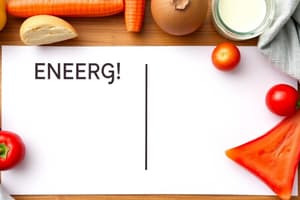Podcast
Questions and Answers
What are the three main reasons we eat food?
What are the three main reasons we eat food?
Energy, compounds for growth, repair, and reproduction, and substances to regulate various functions.
How is food energy measured?
How is food energy measured?
In units known as kilojoules (kJ) and kilocalories (kcal).
1g of protein provides ___ kcal.
1g of protein provides ___ kcal.
4
1g of fat provides ___ kcal.
1g of fat provides ___ kcal.
What is energy balance?
What is energy balance?
Which of the following factors is NOT a component of energy requirements?
Which of the following factors is NOT a component of energy requirements?
The BMR (Basal Metabolic Rate) remains constant throughout life.
The BMR (Basal Metabolic Rate) remains constant throughout life.
What is the estimated increase in energy requirements during pregnancy?
What is the estimated increase in energy requirements during pregnancy?
Which nutrients are associated with fulfilling energy needs?
Which nutrients are associated with fulfilling energy needs?
What is the main difference in energy requirements between men and women?
What is the main difference in energy requirements between men and women?
Flashcards are hidden until you start studying
Study Notes
Nutritional Requirements
- We need food for energy, growth, repair, and reproduction.
- The energy supply comes from protein, carbohydrates, and fats.
- Energy is measured in kilojoules (kJ) and kilocalories (kcal).
- 1 kilocalorie (kcal) is equal to 4.18400 kilojoules (kJ).
- Food provides different amounts of energy based on its nutrient content.
- 1 gram of protein provides 4 kcal.
- 1 gram of carbohydrate provides 4 kcal.
- 1 gram of fat provides 9 kcal.
- We need to balance energy intake with energy expenditure.
Energy Requirements
- Energy requirement is the amount needed to maintain health, growth, and physical activity.
- Energy balance is achieved when energy intake equals energy expenditure, plus the cost of growth, pregnancy, or lactation.
- Energy requirements are estimated based on energy expenditure plus the additional energy needed for growth, pregnancy, and lactation.
Components of Energy Requirements
- Basal metabolism includes essential life functions:
- Cell function and replacement
- Synthesis and secretion of enzymes and hormones
- Transportation of proteins and other substances
- Maintaining body temperature
- Work of the heart, lungs, and brain
- Metabolic response to food requires energy for:
- Ingestion, digestion, absorption, and transport of nutrients
- Physical activity is the largest component of daily energy expenditure, after basal metabolic rate.
- Growth requires energy for:
- Synthesizing growing tissues
- Depositing energy in those tissues
- Pregnancy requires extra energy for:
- Growth of the fetus, placenta, and maternal tissues
- Lactation requires energy for:
- The energy content of milk produced
- Energy required to produce milk
- There are changes in energy requirements with age due to alterations in body composition.
- Basal metabolic rate is higher during childhood and adolescence and decreases in older age.
- Sex differences in energy requirements exist because:
- Men have more muscle mass than women.
- Women have more body fat than men, leading to a slightly lower basal metabolic rate per unit of body weight.
Studying That Suits You
Use AI to generate personalized quizzes and flashcards to suit your learning preferences.




